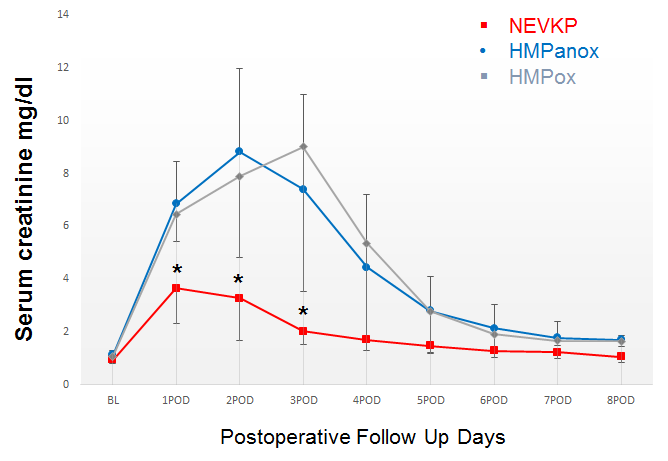Normothermic Ex-Vivo Kidney Perfusion is Superior to Anoxic and Oxygenated Hypothermic Machine Perfusion for the Preservation of DCD Porcine Kidney Grafts
1Multi Organ Transplant Program, Toronto General Hospital, Toronto, ON, Canada, 2Department of General, Visceral, and Transplantation Surgery, University Hospital Essen, Essen, Germany, 3Department of Transplantation and Surgery, Semmelweis University, Budapest, Hungary, 4Departments of Surgery(Urology)&Physiology, The Hospital for Sick Children, Toronto, ON, Canada, 5Laboratory Medicine & Pathobiology, Toronto General Hospital, Toronto, ON, Canada, 6Division of Nephrology, The Hospital for Sick Children, Toronto, ON, Canada
Meeting: 2020 American Transplant Congress
Abstract number: 525
Keywords: Kidney transplantation, Machine preservation, Pig, Renal ischemia
Session Information
Session Name: Basic: Ischemia Reperfusion & Organ Rehabilitation III
Session Type: Oral Abstract Session
Date: Saturday, May 30, 2020
Session Time: 3:15pm-4:45pm
 Presentation Time: 4:27pm-4:39pm
Presentation Time: 4:27pm-4:39pm
Location: Virtual
*Purpose: To increase the donor pool, better preservation strategies for the storage of marginal kidney grafts are crucial. Currently, kidney grafts are either stored on ice or perfused at 4 degrees Celsius without oxygen. Various recent studies showed evidence for improved graft function after transplantation when oxygen is provided during hypothermic machine perfusion (HMP). Moreover, over the last years, a novel technique, normothermic ex-vivo kidney perfusion (NEVKP), was developed with promising results regarding graft function and survival. We compared NEVKP with anoxic HMP (HMPanox) and oxygenated HMP (HMPox) in a porcine kidney autotransplantation model.
*Methods: After 30 minutes of warm ischemia, porcine kidneys were removed and preserved either with HMPanox, HMPox or NEVKP for 16 hours, followed by contralateral nephrectomy and autotransplantation (n=5 per group). Animals were followed for 8 days and graft function was assessed.
*Results: Postoperative graft assessment demonstrated improved graft function with more rapid recovery for the NEVKP preserved grafts compared to both HMPanox and HMPox grafts (mean peak serum creatinine: 3.66+/-1.33mg/dl on POD1, 8.83+/-3.17mg/dl on POD2, and 9.02+/-5.5mg/dl on POD3, respectively). Differences in daily serum creatinine levels are significant between NEVKP and both HMP anox and HMPox on postoperative days 1 – 3 (all p< 0.05). Moreover, on postoperative day 3, creatinine clearance was increased in the NEVKP group compared to the other two groups (p = 0.001).
*Conclusions: In a DCD model of renal autotransplantation, grafts preserved with NEVKP demonstrated significantly better function compared to both anoxic and oxygenated HMP. NEVKP appears to offer better preservation in DCD kidney grafts compared to hypothermic machine perfusion.
To cite this abstract in AMA style:
Mazilescu L, Kaths M, Urbanellis P, Hamar M, Goto T, Linares-Cervantes I, Noguchi Y, Konvalinka A, Ghanekar A, Bagli D, John R, Robinson L, Selzner M. Normothermic Ex-Vivo Kidney Perfusion is Superior to Anoxic and Oxygenated Hypothermic Machine Perfusion for the Preservation of DCD Porcine Kidney Grafts [abstract]. Am J Transplant. 2020; 20 (suppl 3). https://atcmeetingabstracts.com/abstract/normothermic-ex-vivo-kidney-perfusion-is-superior-to-anoxic-and-oxygenated-hypothermic-machine-perfusion-for-the-preservation-of-dcd-porcine-kidney-grafts/. Accessed December 27, 2025.« Back to 2020 American Transplant Congress

